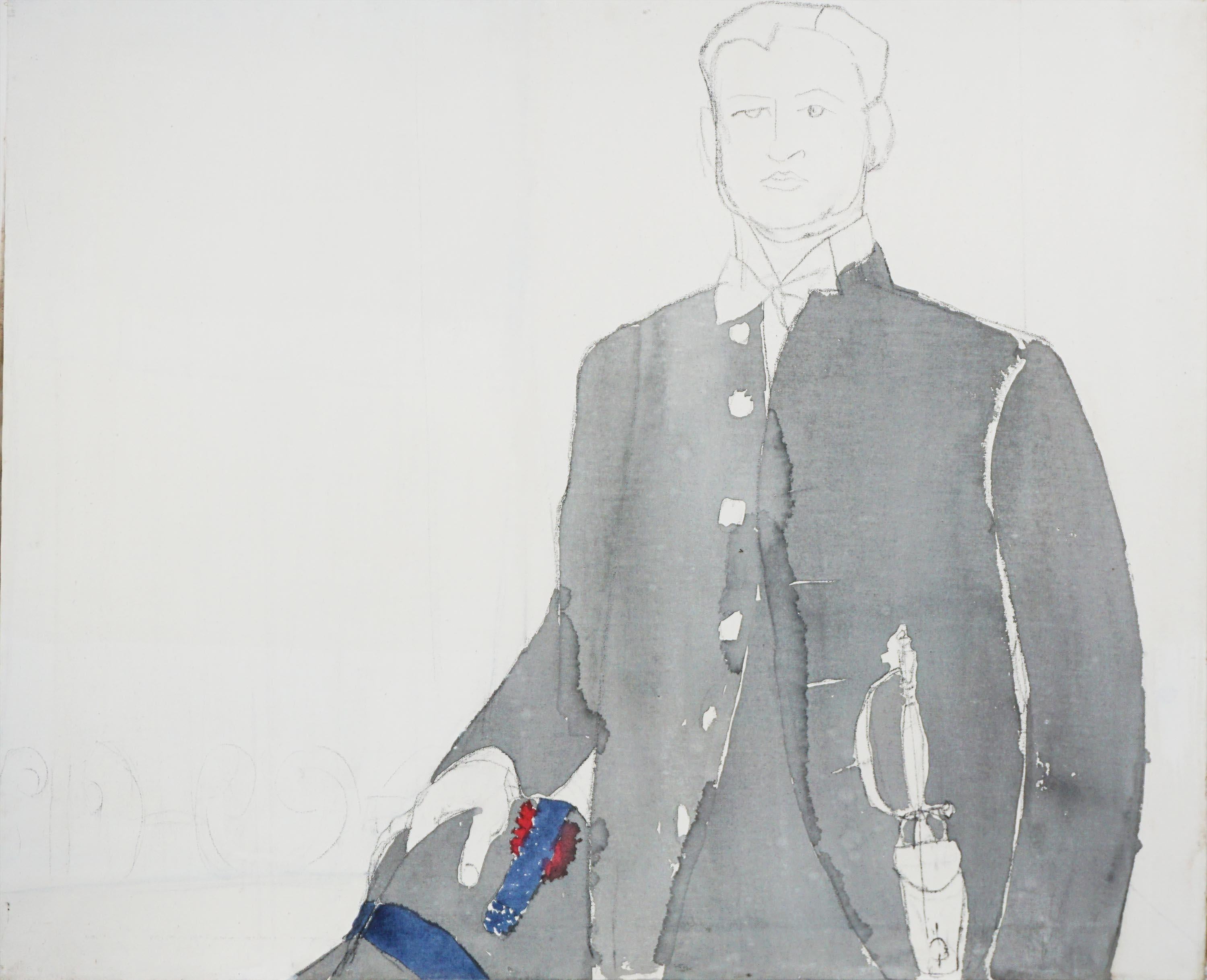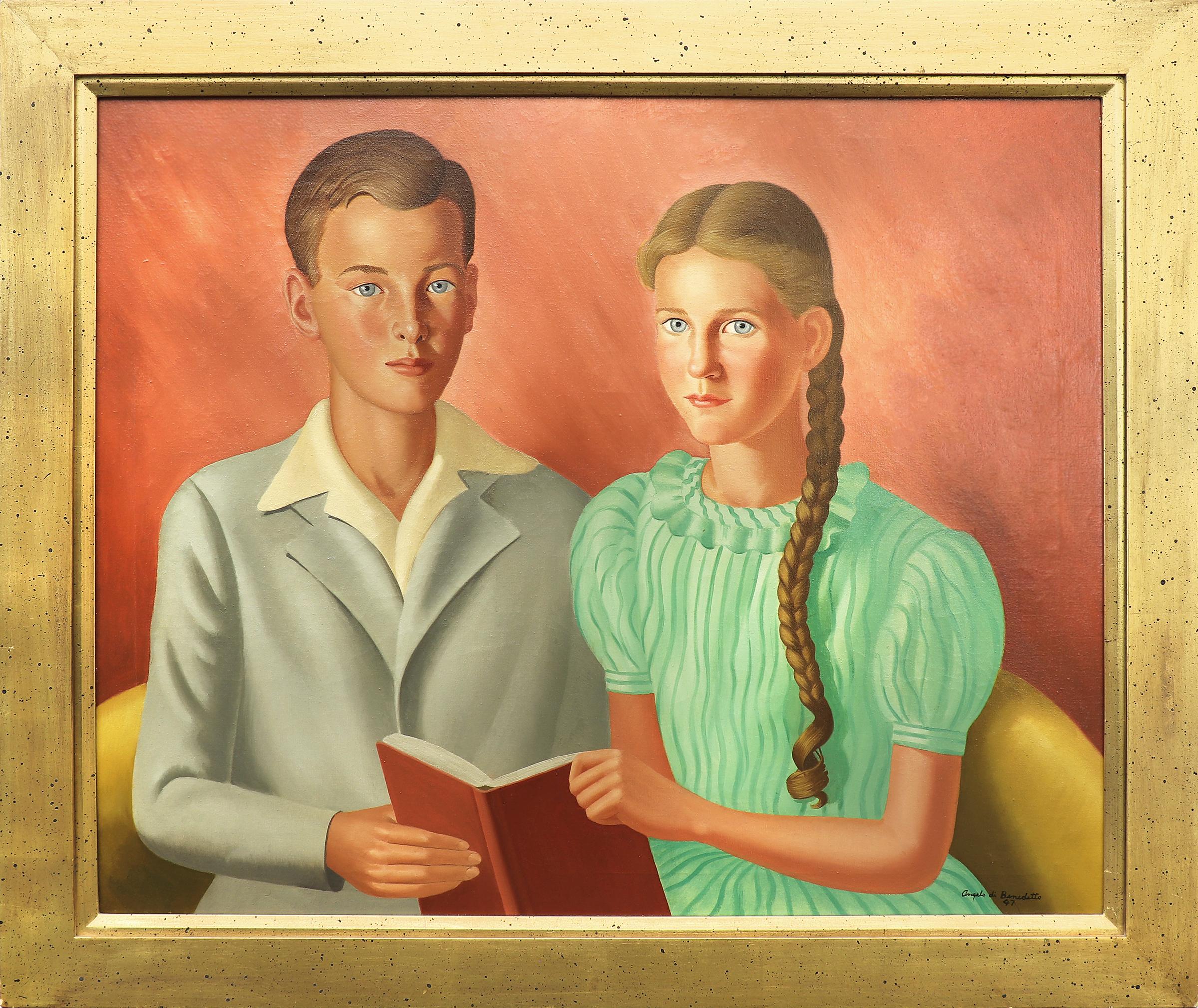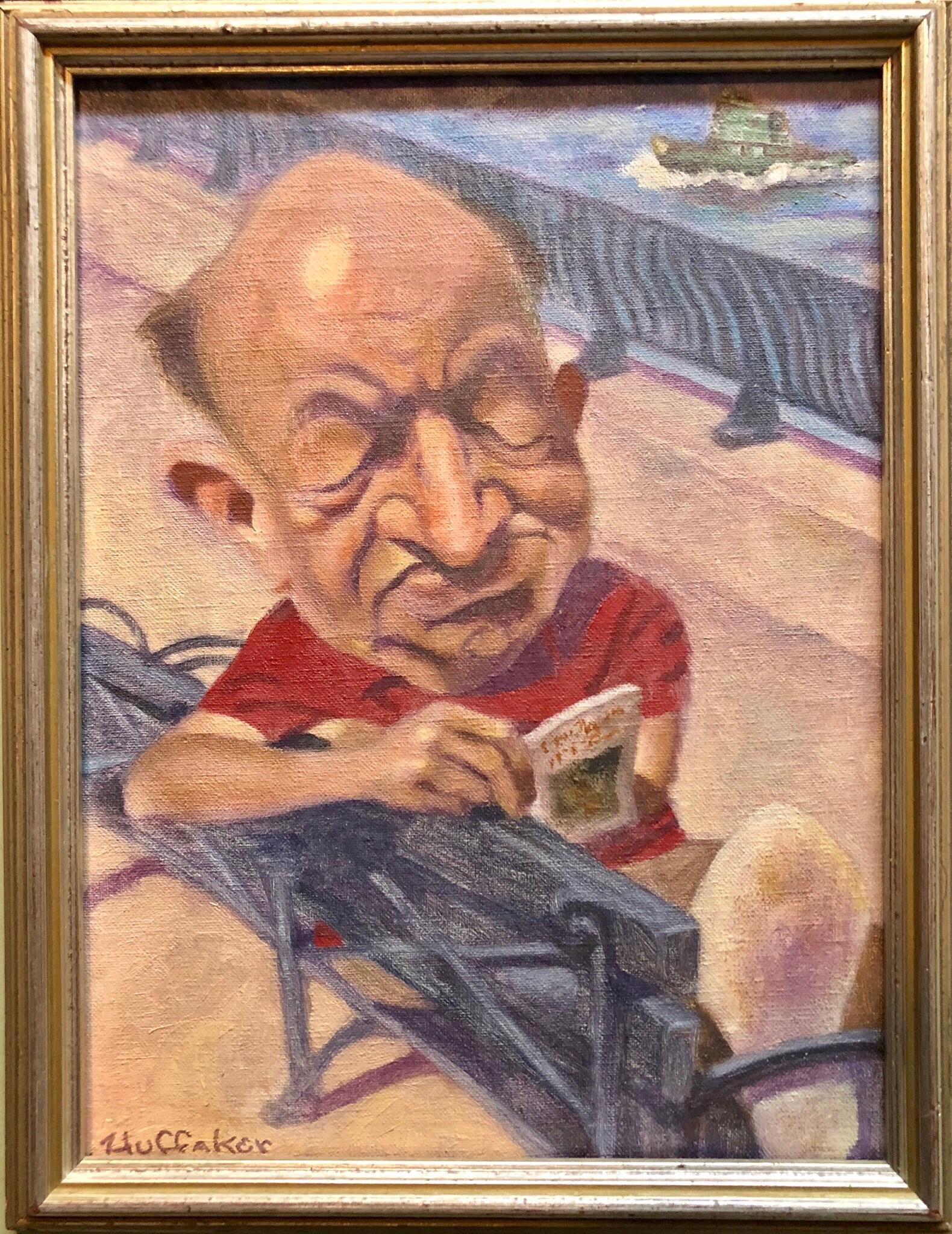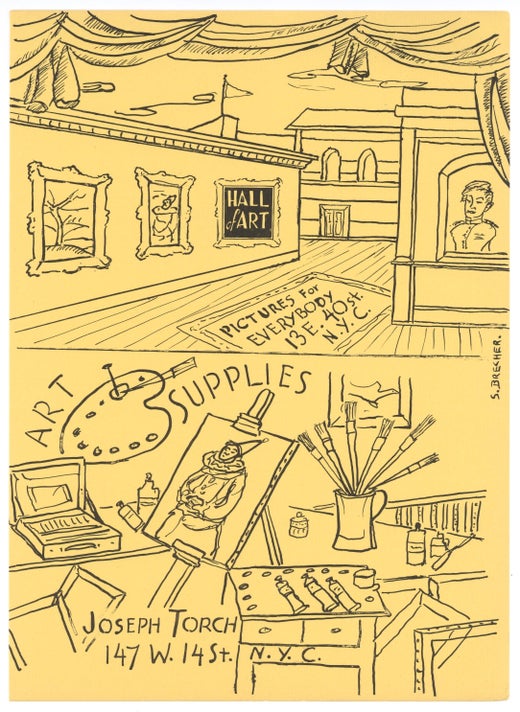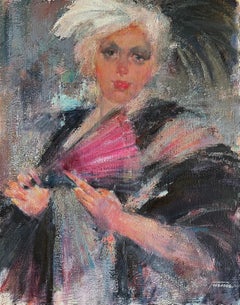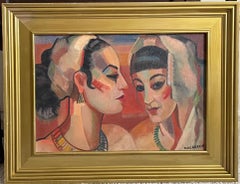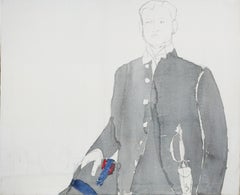
The Ring Master
View Similar Items
Samuel BrecherThe Ring Master1940
1940
About the Item
- Creator:Samuel Brecher (1897-1982, American)
- Creation Year:1940
- Medium:
- Movement & Style:
- Period:
- Condition:
- Gallery Location:Los Angeles, CA
- Reference Number:1stDibs: LU39519592
Samuel Brecher
Samuel Brecher was born in Boryslaw, Austria, a town near the Carpathian Mountains, now a part of Poland. His family came to New York in 1910, where Samuel graduated from Cooper Union in 1921. He studied art at the National Academy of Design from 1921–24 and continued studies under Charles W. Hawthorne in Provincetown, Massachusetts. Brecher was represented by several well known New York City galleries in the 1940s and 1950s, including the Kraushaar Galleries, the ACA Galleries, the Hudson Walker Gallery and the Merrill Gallery. During his career, he won over 40 prestigious prizes and awards and had numerous one-man shows. Brecher's works are included in many important private collections as well as the Metropolitan Museum of Art, the Walker Art Museum, the Smithsonian and the Newark Museum of Art. He is listed in Who's Who in American Art and is a member of the Salmagundi Club and the National Academy of Art.
- BLONDE WITH ART DECO NECKLACELocated in Los Angeles, CABiography from the niece of the artist from during his lifetime. Paintings acquired from the artist.s estate. Max Turner 1925 - 2019 Max Lamar Turner Painter, Sculptor, Teacher and Author. Max Turner was born in Omaha, Nebraska on July 28, 1925. His father was Lance Howard Turner and his mother Mary Irene Turner. In 1927, his family moved to Bingham Canyon, Utah where Max's father extracted copper from a creek that he had diverted to pass through his garage. The town was located in a narrow canyon on the eastern face of the Oquirrh Mountains. In 1938, when Max was 13, his family moved to Midvale, Utah. After completing high school, Max went to work laying rail until he was inducted into the U.S. Navy to serve during W.W. II. There he took an aptitude test and was initially assigned to the medical corp., later transferring to the dental unit. Max was stationed at Port Hueneme, Ventura County, California through the end of the war. When he was discharged in 1946, he remained in Southern California, living in the Los Angeles area. He met a man named Larry Torres and they formed a partnership to do silk screen work primarily for the Colby Poster Printing Company. This lasted about 10 years until the Colby building caught fire and burned down. In 1958, Max began working for Slade Novelty company that made doll parts using a product called plastisol. A year later, Max began producing plastic parts through his own business. One day, a couple of kids brought in a shrunken skull they had made and asked Max if he could reproduce it. Max said he could and he looked around for a business to work with for this task. He ultimately decided he could create his own machine shop to make molds. As a result, Max purchased a lathe, drill press, grinder and other tools to create his own machine shop and went into business making molds. He built a clientele and in 1973, he moved his machine shop to Glendale, California. Painter, Sculptor, Teacher and Author: Max recalls the day when his interest in art took a new direction. He happened to be in a paint store to purchase some supplies when he saw a card posted on a wall that read, "Come paint with Connie Marlo". Max had been interested in art since his youth and he was frequently impressed with paintings displayed by local artists at various community events. Consequently, he decided to go to Connie's Saturday morning art class at a studio on North La Brea Avenue (between Sunset and Hollywood) in Los Angeles. But, as fate would have it, he immediately took a detour from this class when he found a piece of paper on the floor of the studio referencing another art class dealing with compositions, patterns, rhythms and color harmony. The instructor's name was Hal Reed, a former art student of the Russian/American Master, Nicolai Fechin. Hal owned the building (previously the Will Foster Studio) and had founded the Art League of Los Angeles. When Max found Hal, he asked Hal if he could join his class. Hal said "No, the class was full" but he said Max could monitor the class in the back of the classroom. Max took him up on the offer and began observing the weekly class. During the class, Hal told his students that they should practice what they were learning by going to "live model" classes. Max began attending these classes where he learned how to draw figures. After a few months, Hal and Max became good friends. Hal was so impressed with Max's work that he offered Max the opportunity to teach at another location that Hal was opening in the San Fernando Valley. Max accepted the offer and began teaching his own art class. For Max, it was a quick jump from learning to teaching. Max then found that several of his students had to commute to his art class from the west end of the "Valley". To better serve this group of students, Max decided to relocate to another studio in Calabasas. Max continued teaching, and at this time he was producing very impressive portraits, both oil paintings and charcoal drawings from live models (Max never worked from photos). Max demonstrated real talent, and the style of his drawings and paintings were being compared to those of Nicolai Fechin. And, like Fechin, Max also had an interest in sculpting. One day, Max decided to design and cast a bronze owl sculpture to put in his Calabasas Fine Art Gallery. Later, someone approached Max when he was at the foundry and asked him about his success selling the owl sculpture. The individual who asked this question was convinced that there was a broader market for these sculptures and he ordered a dozen of the owl sculptures from Max. This encouraged Max to do more castings. Some of the new castings were antique sculptures he found and reproduced. As this new business grew, he decided to establish his own foundry, employing up to 15 workers. The business continued for many years, up until the late 1990's when Max got tired of the foundry business and sold it. Max, who was now in his 70's, decided to move on to his next venture as an artist, dedicating himself to doing the actual sculpting of original art. He loved the creativity of sculpting and he had his sculptures cast at local foundries, ironically the same ones that used to be his competition. Max was now fully engaged in his new artistic direction and, over time, he produced a large body of work. He created very impressive sculptures, including about 100 full-size sculptures. He sold some of these to high-end clientele, the Foundry at SLS Las Vegas, and to Hollywood studios. Even though Max now seemed to be totally in his element, he somehow also found time to continue to teach painting classes at the California Art Institute in Westlake Village in Los Angeles. At the institute, he specialized in figure work. Max continued to draw, paint and teach, but he says he stopped sculpting when he turned 90. Max produced four books showcasing his drawings and paintings. The first is "Faces, The Drawings of Max Turner", copyright 2000, that showcases nearly 100 of his portrait drawings. Within the "Acknowledgements" section, he lists Hal Reed and Joseph Nordmann, two former students of Nicolai Fechin. In 2006, Max produced his second book titled "Figures and Faces", reflecting not only portraits but also figure drawings and paintings. It is a wonderful book of Max's work, but it is currently difficult to find. The third book is titled "Faces 2, The Paintings and Drawings of Max Turner", copyright 2009, which includes 75 portrait paintings and drawings. In the "Preface" of this book, Max describes growing up in a small and isolated mining town during the Great Depression. He states that as a kid, he had little exposure of any culture or view of what the rest of the world was like. His neighbor was the trash collector and Max would sometimes go through his truck looking for anything of value. Among other things, he found magazines like Cosmopolitan, Good Housekeeping and Red Book, with covers that frequently showed drawings or paintings of faces. Max states that these images were the very first source of inspiration for him. He says that he began looking more carefully at people's faces and if they had character, he would draw them. By drawing them, Max says that he was making them part of his world, his world of "Faces". In 2018, Max published his newest book showcasing his drawings and paintings. It is titled "Max Turner's Figure Sketches". This softbound book includes 76 pages and over 120 drawings and paintings. In the Introduction, Max explains "I have found that when approaching the figure, one should begin with the gesture. After having captured the essence or feeling of the pose, one can then proceed to build on it." The figure sketches in this wonderful book reflect a Master's work that consistently captures the "gesture"-showing the emotion, movement and expression. Two more books are on the horizon for Max, both dealing with his passion for sculpting. His first, "The Sculpture of Max Turner" is a compilation of his commercial and noncommercial pieces throughout his career. The second, "Terra Cotta Sculpture by Max Turner" is a complete collection of figures done at the California Art Institute. These much anticipated books should be out later in 2018. Max now considers himself primarily a sculptor. But others in the art world are more than impressed with his drawings and paintings as well. His portraits are often described as having a Fechin-esque appearance, referring to the style of Nicolai Fechin. When Max observed those first art classes given by Hal Reed, it should be noted that Hal had previously been a student of the Russian/American Master Nicolai Fechin in the early to mid-1950's. In fact, Hal was a student in the last art class that Fechin taught before he unexpectedly died in 1955. Hal was so strongly influenced by Fechin that he later produced two 30-minute art instruction videos as part his Art Video Productions wherein he specifically described Fechin techniques that he learned in Fechin's class. The Fechin style and techniques were in play when Max later met Hal. Over the years, many of Max's art students, art collectors, gallery owners, as well as the Director of the Monterey Museum of Art have commented on the Fechin-esque qualities of Max's wonderful charcoal drawings and paintings. So, while Max may consider himself primarily a sculptor, his drawings and paintings are also impressive and very much sought after. When Nicolai Fechin died in 1955, three of the nine students in his last art class became life-long friends. Max subsequently became friends with not only Hal Reed, but also with prior Fechin students Joseph Nordmann and Albert Londraville...Category
1990s Modern Figurative Paintings
MaterialsOil, Canvas
$650 Sale Price48% Off - LADY WITH PICK FANLocated in Los Angeles, CABiography from the niece of the artist from during his lifetime. Paintings acquired from the artist.s estate. Max Turner 1925 - 2019 Max Lamar Turner Painter, Sculptor, Teacher and Author. Max Turner was born in Omaha, Nebraska on July 28, 1925. His father was Lance Howard Turner and his mother Mary Irene Turner. In 1927, his family moved to Bingham Canyon, Utah where Max's father extracted copper from a creek that he had diverted to pass through his garage. The town was located in a narrow canyon on the eastern face of the Oquirrh Mountains. In 1938, when Max was 13, his family moved to Midvale, Utah. After completing high school, Max went to work laying rail until he was inducted into the U.S. Navy to serve during W.W. II. There he took an aptitude test and was initially assigned to the medical corp., later transferring to the dental unit. Max was stationed at Port Hueneme, Ventura County, California through the end of the war. When he was discharged in 1946, he remained in Southern California, living in the Los Angeles area. He met a man named Larry Torres and they formed a partnership to do silk screen work primarily for the Colby Poster Printing Company. This lasted about 10 years until the Colby building caught fire and burned down. In 1958, Max began working for Slade Novelty company that made doll parts using a product called plastisol. A year later, Max began producing plastic parts through his own business. One day, a couple of kids brought in a shrunken skull they had made and asked Max if he could reproduce it. Max said he could and he looked around for a business to work with for this task. He ultimately decided he could create his own machine shop to make molds. As a result, Max purchased a lathe, drill press, grinder and other tools to create his own machine shop and went into business making molds. He built a clientele and in 1973, he moved his machine shop to Glendale, California. Painter, Sculptor, Teacher and Author: Max recalls the day when his interest in art took a new direction. He happened to be in a paint store to purchase some supplies when he saw a card posted on a wall that read, "Come paint with Connie Marlo". Max had been interested in art since his youth and he was frequently impressed with paintings displayed by local artists at various community events. Consequently, he decided to go to Connie's Saturday morning art class at a studio on North La Brea Avenue (between Sunset and Hollywood) in Los Angeles. But, as fate would have it, he immediately took a detour from this class when he found a piece of paper on the floor of the studio referencing another art class dealing with compositions, patterns, rhythms and color harmony. The instructor's name was Hal Reed, a former art student of the Russian/American Master, Nicolai Fechin. Hal owned the building (previously the Will Foster Studio) and had founded the Art League of Los Angeles. When Max found Hal, he asked Hal if he could join his class. Hal said "No, the class was full" but he said Max could monitor the class in the back of the classroom. Max took him up on the offer and began observing the weekly class. During the class, Hal told his students that they should practice what they were learning by going to "live model" classes. Max began attending these classes where he learned how to draw figures. After a few months, Hal and Max became good friends. Hal was so impressed with Max's work that he offered Max the opportunity to teach at another location that Hal was opening in the San Fernando Valley. Max accepted the offer and began teaching his own art class. For Max, it was a quick jump from learning to teaching. Max then found that several of his students had to commute to his art class from the west end of the "Valley". To better serve this group of students, Max decided to relocate to another studio in Calabasas. Max continued teaching, and at this time he was producing very impressive portraits, both oil paintings and charcoal drawings from live models (Max never worked from photos). Max demonstrated real talent, and the style of his drawings and paintings were being compared to those of Nicolai Fechin. And, like Fechin, Max also had an interest in sculpting. One day, Max decided to design and cast a bronze owl sculpture to put in his Calabasas Fine Art Gallery. Later, someone approached Max when he was at the foundry and asked him about his success selling the owl sculpture. The individual who asked this question was convinced that there was a broader market for these sculptures and he ordered a dozen of the owl sculptures from Max. This encouraged Max to do more castings. Some of the new castings were antique sculptures he found and reproduced. As this new business grew, he decided to establish his own foundry, employing up to 15 workers. The business continued for many years, up until the late 1990's when Max got tired of the foundry business and sold it. Max, who was now in his 70's, decided to move on to his next venture as an artist, dedicating himself to doing the actual sculpting of original art. He loved the creativity of sculpting and he had his sculptures cast at local foundries, ironically the same ones that used to be his competition. Max was now fully engaged in his new artistic direction and, over time, he produced a large body of work. He created very impressive sculptures, including about 100 full-size sculptures. He sold some of these to high-end clientele, the Foundry at SLS Las Vegas, and to Hollywood studios. Even though Max now seemed to be totally in his element, he somehow also found time to continue to teach painting classes at the California Art Institute in Westlake Village in Los Angeles. At the institute, he specialized in figure work. Max continued to draw, paint and teach, but he says he stopped sculpting when he turned 90. Max produced four books showcasing his drawings and paintings. The first is "Faces, The Drawings of Max Turner", copyright 2000, that showcases nearly 100 of his portrait drawings. Within the "Acknowledgements" section, he lists Hal Reed and Joseph Nordmann, two former students of Nicolai Fechin. In 2006, Max produced his second book titled "Figures and Faces", reflecting not only portraits but also figure drawings and paintings. It is a wonderful book of Max's work, but it is currently difficult to find. The third book is titled "Faces 2, The Paintings and Drawings of Max Turner", copyright 2009, which includes 75 portrait paintings and drawings. In the "Preface" of this book, Max describes growing up in a small and isolated mining town during the Great Depression. He states that as a kid, he had little exposure of any culture or view of what the rest of the world was like. His neighbor was the trash collector and Max would sometimes go through his truck looking for anything of value. Among other things, he found magazines like Cosmopolitan, Good Housekeeping and Red Book, with covers that frequently showed drawings or paintings of faces. Max states that these images were the very first source of inspiration for him. He says that he began looking more carefully at people's faces and if they had character, he would draw them. By drawing them, Max says that he was making them part of his world, his world of "Faces". In 2018, Max published his newest book showcasing his drawings and paintings. It is titled "Max Turner's Figure Sketches". This softbound book includes 76 pages and over 120 drawings and paintings. In the Introduction, Max explains "I have found that when approaching the figure, one should begin with the gesture. After having captured the essence or feeling of the pose, one can then proceed to build on it." The figure sketches in this wonderful book reflect a Master's work that consistently captures the "gesture"-showing the emotion, movement and expression. Two more books are on the horizon for Max, both dealing with his passion for sculpting. His first, "The Sculpture of Max Turner" is a compilation of his commercial and noncommercial pieces throughout his career. The second, "Terra Cotta Sculpture by Max Turner" is a complete collection of figures done at the California Art Institute. These much anticipated books should be out later in 2018. Max now considers himself primarily a sculptor. But others in the art world are more than impressed with his drawings and paintings as well. His portraits are often described as having a Fechin-esque appearance, referring to the style of Nicolai Fechin. When Max observed those first art classes given by Hal Reed, it should be noted that Hal had previously been a student of the Russian/American Master Nicolai Fechin in the early to mid-1950's. In fact, Hal was a student in the last art class that Fechin taught before he unexpectedly died in 1955. Hal was so strongly influenced by Fechin that he later produced two 30-minute art instruction videos as part his Art Video Productions wherein he specifically described Fechin techniques that he learned in Fechin's class. The Fechin style and techniques were in play when Max later met Hal. Over the years, many of Max's art students, art collectors, gallery owners, as well as the Director of the Monterey Museum of Art have commented on the Fechin-esque qualities of Max's wonderful charcoal drawings and paintings. So, while Max may consider himself primarily a sculptor, his drawings and paintings are also impressive and very much sought after. When Nicolai Fechin died in 1955, three of the nine students in his last art class became life-long friends. Max subsequently became friends with not only Hal Reed, but also with prior Fechin students Joseph Nordmann and Albert Londraville...Category
1990s Modern Figurative Paintings
MaterialsOil, Canvas
$450 Sale Price64% Off - AlexandriaBy Buckley MacGurrinLocated in Los Angeles, CABUCKLEY MACGURRIN "ALEXANDRIA" OIL ON CANVAS, SIGNED, TITLED AMERICAN, DATED 1949 EXHIBITED: DALZELL-HATFIELD GALLERY 14 X 20 INCHES Buckley MacGurrin 1896 –1971 Buckley MacG...Category
1940s Art Deco Figurative Paintings
MaterialsOil, Canvas
- RelaxingBy Richard GeigerLocated in Los Angeles, CARICHARD GEIGER "RELAXING" OIL ON CANVAS, SIGNED HUNGARIAN, C.1930 28 X 39 INCHES FRAMED 36.5 X 46 INCHES Richard Geiger 1870-1945 Richard Geiger was born in Vienna and first studied at the Vienna Art Institute with the academic painter Christian Ludwig Von Griepenkerl and, subsequently, in Paris with Francois Flameng...Category
1930s Art Deco Portrait Paintings
MaterialsCanvas, Oil
$1,625 Sale Price50% Off - Woman with DogBy Reza AfrookhtehLocated in Los Angeles, CASize with frame: 34 x 28 Inches Reza begun studying art seriously at age 15 and was studying at the institute of art in Iran where he graduated with highest honors. He also studied...Category
Early 2000s Realist Figurative Paintings
MaterialsOil, Canvas
Price Upon Request - Man with Yellow TieLocated in Los Angeles, CAALEXANDER KREISEL "MAN WITH YELLOW TIE" OIL ON CANVAS BOARD, SIGNED RUSSIAN-AMERICAN, C.1935 26 X 19.5 INCHES FRAMED 29.5 X 23.5 INCHES Alexander Krei...Category
1930s Expressionist Figurative Paintings
MaterialsOil, Canvas
$1,688 Sale Price24% Off
- Modernist Portrait of St. FrancisBy Tarmo PastoLocated in Soquel, CAModernist Portrait of St. Francis Compelling modernist oil on canvas portrait of St. Francis by Dr. Tarmo Pasto (American, 1906-1986). Presented in a taupe painted wood frame. Signed "Tarmo Pasto" bottom right, and titled "St. Francis" bottom center. Image size, 25.5"H x19.5"L. Dr. Pasto was a long-time contributor to the California art scene, as well as an art teacher and psychologist to many successful artists. He also authored a book on art, "The Space-Frame Experience in Art", published in 1964. He, however, was mainly known to the world for introducing the works of one of his patients, Martin Ramirez...Category
1970s American Modern Figurative Paintings
MaterialsOil, Canvas
$2,280 Sale Price20% Off - Mid-Century Modern Man - Portrait in Oil on CanvasLocated in Soquel, CASubtle and moody portrait of a Pensive man by Joan Tidwell (American, 1930-2002). The sitter in the portrait is a middle-aged man looking slightly downwards, wearing a collared shirt. This piece is completed in a tan and green palette, creating a somber feeling. Of particular note are the confident, thick brushstrokes - each one is well-placed in the modernist style. Similar in some ways to Picasso's portraits. Signed "Joan Tidwell" on verso Unframed. Canvas size: 30"H x 22"W oan Gay Tidwell (American, 1930-2002) was born and raised in Hollywood, CA, where she had some success as a child actor. Later, she graduated Magna Cum Laude from the University of Washington with a Master's Degree in English Literature and Drama. Tidwell moved to the Bay...Category
1960s American Modern Portrait Paintings
MaterialsCanvas, Oil
- Modernist Unfinished Portrait -- Handsome Man in Dress UniformBy Patricia Gren HayesLocated in Soquel, CAModern unfinished portrait of handsome man in dress uniform by American painter, Patricia Gren Hayes (b. 1932), circa 1970. Unsigned. Provenance: Purchased as part of larger collection of artist's work from the estate of Larry Miller Unframed. Canvas size: 30"H x 36"W. Patricia Gren Hayes (American, b. 1932) is a Bay Area Figurative & Feminist Art Movement artist who studied at Winnipeg Public Art School in 1950. She received early recognition in Museum and Gallery competitions and exhibitions and was awarded a Special Education in Art recognition by the Winnipeg Museum of Fine Art, and was awarded a scholarship to the Banff College of Fine Art. Further studies were at The University of Manitoba. She was a Member of Winnipeg Free Press Sketch Club and was a Cartoonist and paste-up for a French-English bi-weekly, in Eastern Canada; She studied outdoor impressionism in New York in 1960; in 1962, attended The California College of Arts and Crafts, and in 1976 B.A., U.C. Berkel...Category
1970s American Modern Figurative Paintings
MaterialsOil, Canvas
- Modern Figurative Study of Three Women in Oil on CanvasBy Patricia Gren HayesLocated in Soquel, CAFigurative study of women by American painter, Patricia Gren Hayes (b. 1932). Blonde long hair women wearing overalls, side view of same woman and another side view study of a brunette, circa 1970. "Gren Hayes" on verso stretcher. Provenance: Purchased as part of larger collection of artist's work from Larry Miller Fine Art. Unframed. Canvas size: 29"H x 29"W Patricia Gren Hayes (American, b. 1932) is a Bay Area Figurative & Feminist Art Movement artist who studied at Winnipeg Public Art School in 1950. She received early recognition in Museum and Gallery competitions and exhibitions and was awarded a Special Education in Art recognition by the Winnipeg Museum of Fine Art, and was awarded a scholarship to the Banff College of Fine Art. Further studies were at The University of Manitoba. She was a Member of Winnipeg Free Press Sketch Club and was a Cartoonist and paste-up for a French-English bi-weekly, in Eastern Canada; She studied outdoor impressionism in New York in 1960; in 1962, attended The California College of Arts and Crafts, and in 1976 B.A., U.C. Berkeley where she studied under Elmer Bischoff, David Simpson, Joan Brown, Felix Ruvolo, Yolanda Lopez and Vincent Perez. She started a freelance commercial art business in 1963; copyrighted a National Cartoon, 1976, and served as Exhibition Director for San Francisco Woman Artists Gallery and the San Francisco Museum of Modern Art, 1976-1978. She was a workshop instructor at the San Francisco Woman Artists Gallery, 1977-1985; and was Manager/Owner Stanton Art Gallery, Alameda, CA, 1976-1982. Solo Exhibitions: Berkeley Marina, 1974; Oakland Center for The Visual Arts, "Images of Women", 1979 Group Exhibitions: Oakland's Dept of Education, 1963, Studio One; Alameda County Fair, 1975, 1976, 1978; San Francisco Art Festival, 1969, 1970, 1976, 1977, 1978; San Francisco Museum of Modern Art, 1976, 1977, 1978; San Francisco Women Artists Gallery Exhibition, award winner - 1970, 1977, 1978; Hayward Bay Fair Art Festival, award winner - 1971; Capricorn Assunder Gallery, 1973; Oakland Art Festival, 1973, 1974; Alameda Art Association, 1978; El Cerrito...Category
1970s American Modern Figurative Paintings
MaterialsOil, Canvas
- Modern Portrait of Young Girl "Cathy" Oil on CanvasBy Patricia Gren HayesLocated in Soquel, CAModern portrait of young girl named Cathy Gutman by American painter, Patricia Gren Hayes (b. 1932), 1982. Signed and dated lower left corner and on verso Provenance: Purchased as part of larger collection of artist's work from the estate of Larry Miller fine Art Unframed. Canvas size: 18"H x 16"W. Patricia Gren Hayes (American, b. 1932) is a Bay Area Figurative & Feminist Art Movement artist who studied at Winnipeg Public Art School in 1950. She received early recognition in Museum and Gallery competitions and exhibitions and was awarded a Special Education in Art recognition by the Winnipeg Museum of Fine Art, and was awarded a scholarship to the Banff College of Fine Art. Further studies were at The University of Manitoba. She was a Member of Winnipeg Free Press Sketch Club and was a Cartoonist and paste-up for a French-English bi-weekly, in Eastern Canada; She studied outdoor impressionism in New York in 1960; in 1962, attended The California College of Arts and Crafts, and in 1976 B.A., U.C. Berkeley where she studied under Elmer Bischoff, David Simpson, Joan Brown, Felix Ruvolo, Yolanda Lopez and Vincent Perez. She started a freelance commercial art business in 1963; copyrighted a National Cartoon, 1976, and served as Exhibition Director for San Francisco Woman Artists Gallery and the San Francisco Museum of Modern Art, 1976-1978. She was a workshop instructor at the San Francisco Woman Artists Gallery, 1977-1985; and was Manager/Owner Stanton Art Gallery, Alameda, CA, 1976-1982. Solo Exhibitions: Berkeley Marina, 1974; Oakland Center for The Visual Arts, "Images of Women", 1979 Group Exhibitions: Oakland's Dept of Education, 1963, Studio One; Alameda County Fair, 1975, 1976, 1978; San Francisco Art Festival, 1969, 1970, 1976, 1977, 1978; San Francisco Museum of Modern Art, 1976, 1977, 1978; San Francisco Women Artists Gallery Exhibition, award winner - 1970, 1977, 1978; Hayward Bay Fair Art Festival, award winner - 1971; Capricorn Assunder Gallery, 1973; Oakland Art Festival, 1973, 1974; Alameda Art Association, 1978; El Cerrito...Category
1980s American Modern Figurative Paintings
MaterialsOil, Canvas
- Bay Area Figurative Movement Patricia Gren HayesBy Patricia Gren HayesLocated in Soquel, CAWonderful figurative by Patricia Gren Hayes (American, 20th Century). Signed on verso. Unframed. Size: 30"H x 40"W. Bay Area Figurative / Bay Area Feminist Art Movement artist, Pat...Category
1970s American Modern Figurative Paintings
MaterialsOil, Canvas
$2,040 Sale Price20% Off


